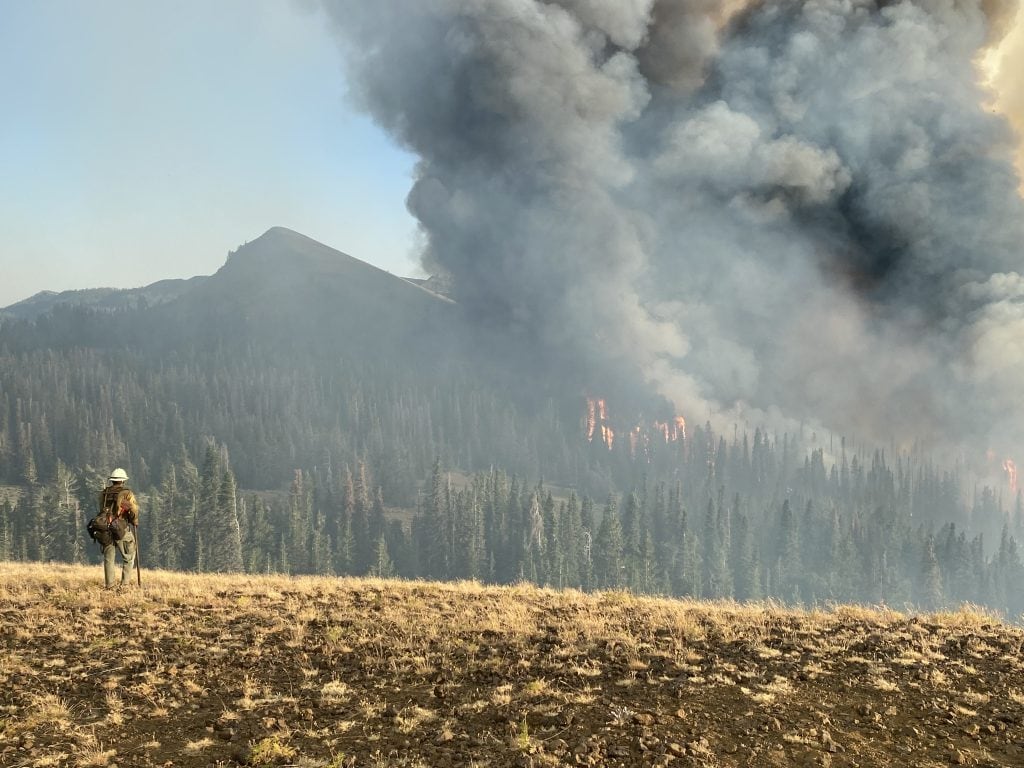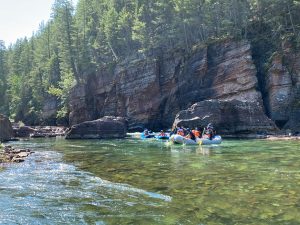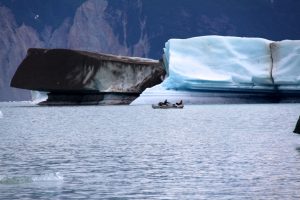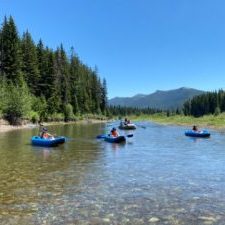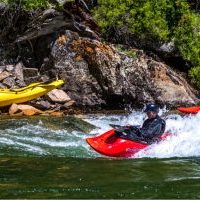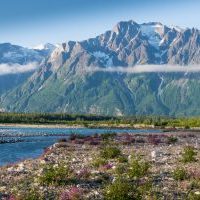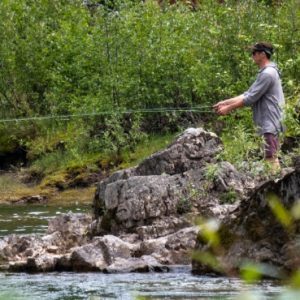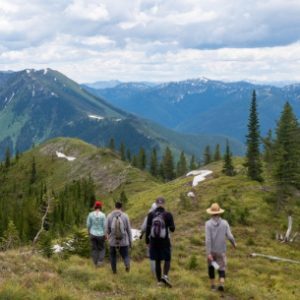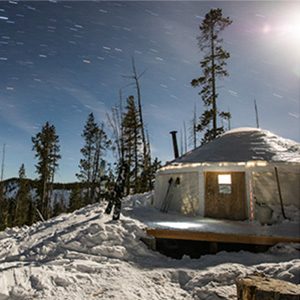The Fire Talk Series, Episode 1: An Interview with a Wildland Firefighter
January 20, 2023
Written by Carly Knudson
About the Fire Talk Series:
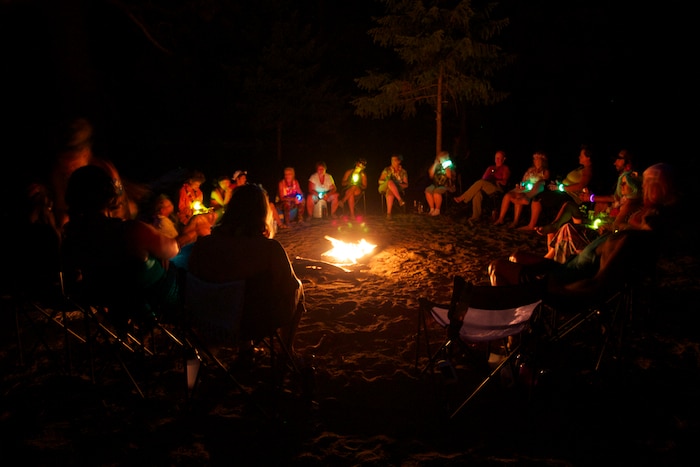
I have met and shared so many wonderful exchanges with so many different types of people and experts in their own domains, which always reminds me to embrace individuality and the uniqueness of each of our lives. Each episode will be inspired by some aspect of guiding, rivers, experiencing wild places, or adventure, and we hope to bring a little bit of Idaho and wonder back to you, wherever you are at in your lives.
Episode 1: The Wildland Firefighter
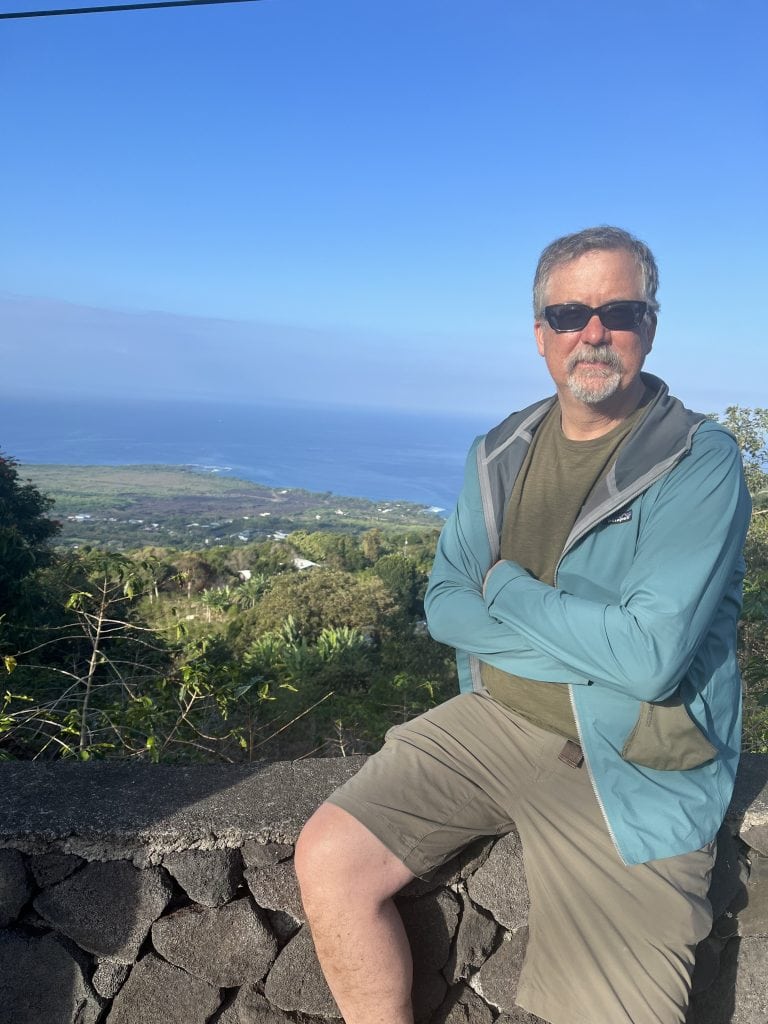
Jeff Knudson recently retired from his 33 year wildland fire career with the Bureau of Land Management and lives in Salmon, ID with his wife, Gina. In his recent retirement, he is keeping busy rebuilding a hotshot buggy into a camper van, brewing and judging beer, riding his bike or skiing, cooking, and chasing steelhead on the local run. Jeff and Gina have two kids (adults he likes to say); Ty, who is continuing on the family wildland fire legacy out of Boise, ID, and Carly, who mostly chases whitewater and mountains and sometimes writes silly blog posts.
Imagine you are floating down the pristine landscape of the Salmon River in late August. The water is clear enough for you to see the bottom of the riverbed; thick groves of Ponderosa Pine and Douglas Fir tower amongst steep granite walls; all you can hear besides the oars rhythmically dipping in the water is the occasional call of the canyon wren echoing between the boats. However beautiful the scenery, you can’t help but notice a sort of density in the air that pulls at your lungs. The sky is darker and a slightly cooler temperature than expected for the middle of an Idaho summer. Instead of its normal incessant bright white glare, the sun has taken on an ominous red hue. You may even see smoke or small flames dancing upon one of the nearby hillsides. You are traveling through fire season in Idaho.
For many of us that have been in wilderness landscapes, we understand that wildfires are a co-existing part of the landscape and ecosystem. While we will still get many smoke-free trips, within the last couple of years, it seems that wildfires are becoming more and more common in our everyday lives, and of a point in daily conversation and news coverage. Personally, I was reminded of the power of fire this year with the Moose Fire near Salmon making headlines as the biggest wildfire in Idaho at one point, the town scattered with fire basecamps, and the City Council calling town hall meetings to discuss mass evacuation plans. On the river, we were also facing the consequences of last season’s Boundary Creek fire on the Middle Fork Salmon, which caused a blowout at Ramshorn Creek that completely changed the entire upper portion of the river corridor, and caused a typically crystal-clear trout fishing water to become a viscous, chocolate brown for most of the fall fishing season.
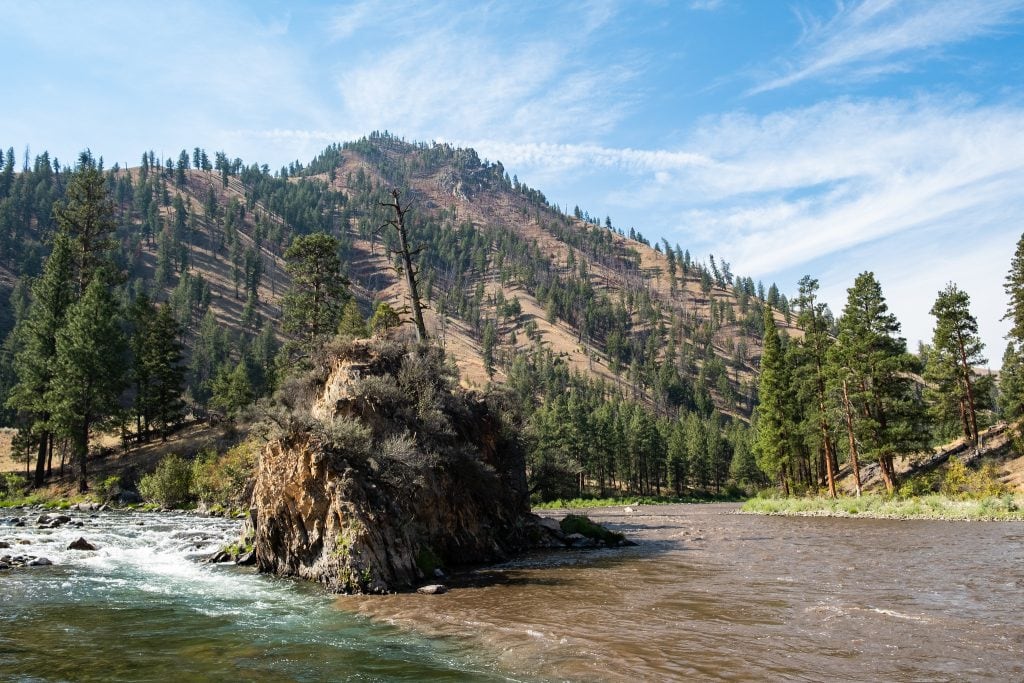
While a fire is an understood part of a river guide’s ecosystem, we are more or less able to float past these fires without too much anxiety. Oftentimes, it is easy to forget the people behind the scenes that make our safety and comfort in the middle of a wildfire season possible. To learn more and gain an insider’s perspective, I consulted with Salmon, Idaho local fire expert, Jeff Knudson, to learn more.
What is your history/ experience with fire as a career and how did you get involved in the wildland firefighting industry?
I began my first season with the BLM in Boise, Idaho in 1988, which happened to be the same year as one of the largest historical fires, the Yellowstone Complex Fire. It burned about 1 million acres out of the 2.2 million in the park. I worked seasonally as a firefighter all through college, and when I graduated I just never really stopped coming back for fire seasons. I worked seasonally until about 1996 when I got my first year-round “career” position, and just retired this last season. I guess that adds up to about 33 years!
What do year-round seasonal employees typically do in the “off-season” at work?
A lot of the work is prepping for the fire seasons to come. Some project-based work might be re-seeding burned areas, building fences, working prescribed burns, completing trainings such as chainsaw work or leadership, or working in other regions that have longer fire seasons. From a management standpoint, you’ll have meetings debriefing or getting ready for the fire season, working through hiring processes or on-boarding, equipment preparation, reviewing fire management plans, etc.
How do wildfires start? What are the percentages of natural versus human-caused fires?
There are two main categories of wildfire starts, environmental or “natural” versus human-cause. Environmental causes typically include lightning or lava, depending on the region. Lighting can hit a tree and spontaneously combust and never start a fire at all, or sometimes it will strike someplace like a small brushy zone, create a sort of ember and not start for days. Human-caused fires often start from things like campfires not being put out, cigarettes, or sparks from things like vehicles, chainsaws, railways, etc. Whether a fire will start has a lot of variability of conditions like time of year, weather, and fuels too.
Environmental versus human-caused fires are often correlated with population size. For example in Idaho, a place like Salmon has about a 90% natural cause to 10% human cause ratio, while more populated areas around places like Boise might have more like 40-70% of wildfires being human caused.
Why is it that in forests you might see patches of a burn area that only one random tree is burned or one that is not burned in the middle of a scorched zone?
This is what’s called a “mosaic burn pattern.” These mixed burn patterns all totally depend on all the dynamic factors that come with the unique nature of each fire. Thinking about things like weather patterns (shifting winds, scattered rains), difference in types of fuels, whether the fire is on a north versus south-facing aspect, or natural “fire lines” in the geography such as big scree fields.
How are wildfires named?
We used to just let firefighters name the fires, but with that you can imagine sometimes there were not-so-nice names that came out of that. Now it’s policy to pick a geographically inspired object (a creek, mountain, etc.) near the origin of the fire. Sometimes you might hear a complex named after the time of year or something like a fire that started on the Fourth of July called the “Firework Fire” or something like that. You want to keep the naming objective and avoid things like naming it after people who started the fire or who were involved in fatalities.
How are wildfires today typically managed? How has fire policy changed over the years?
This is a pretty complicated question, and we could probably talk all day about this one. In general, you can kind of think about the progression of fire management in stages. In the early 1900’s around the era of the “Big Burn,” fire management was just beginning to be viewed as a national issue, and placed in the hands of government control. It was a time that a majority of agencies viewed all fire as bad, and had 100% suppression policies. There were policies in place such as the “10 am policy,” in which all fires everywhere were supposed to be completely put out from the start by 10 am the following morning. Until almost the 70’s and 80’s, this was the case, until there was realization of the ecological benefits of fire, in which another extreme philosophy came into place of more or less “letting it burn.” This also wasn’t that sustainable, and in today’s policies it’s an understanding of a mix between the two depending on a lot of circumstances that you need to take into account when making a fire plan.
Generally, every single acre of national forest and state-owned land is accounted for with a fire management plan. These plans account for resources available, potential fuels, ecosystems and habitats at risk, weather patterns and times of the year, nearby residential regions or high-use areas, etc. Depending on the fire, there are direct or indirect ways of managing a fire. More direct ways might be planes with fire retardants, helicopters with water buckets, or firefighters actively building fire lines near the fire. More indirect management may include drone survielence, watching and predicting weather patterns, utilizing natural features such as watersheds or large rocks, or building preventative fire lines miles away.
Management plans also take into account whether or not the fire is in a wilderness area, a national forest or park, or near urban interfaces.
What are the costs versus benefits of wildfire?
A lot of fire management is considering a sort of “risk versus reward” mentality. You can think about cost in a literal, fiscal way, in terms of how much agencies will need to pay for staff, equipment, etc., or in terms of lives/safety, loss of revenue (such as something like the Boundary Creek fire in the middle of a Middle Fork river season), or structures/ protected regions that are threatened. There also can be floods, blowouts or mudslides from compromised soils, or threatened wildlife habitat.
On the other hand, there are many positive, essential aspects of fire. When people ask me why we should let fires burn, I think to myself, “Why wouldn’t you let the sun rise in the morning?” Fires more or less help maintain ecosystems’ equilibrium, and are a part of nature’s process of resetting, reclaiming, improving, and adjusting its natural environment. Healthy fires help to clear ground fuels and avoid massive, out of control fires that can occur when fuels build up, can benefit riparean habitats with essential wood debris and nutrients, or clear invasive species. Another example are trees such as the Lodgepole Pine, which rely on forest fires for reproduction; their pinecones rely on fire to reach a certain temperature in order to open and spread the seeds that are inside.
Are there typical lifecycles of fires that are considered to be “healthy”?
Again, this one depends. There’s not really a magical number, but varies based on the ecosystem and fuels. While it’s common and healthy for grasslands or brushy, desert areas to burn every 5 or so years, rainforests may not need to burn more than one in 500 years. Obviously there’s a lot in between that for different types of pine forests.
Are there any common wildfire myths to debunk?
There is a misconception that when you don’t see firefighters physically on the ground that agencies are “doing nothing.” Even if there are not active management techniques in place at a given moment in time, there are always people managing a fire from the very start to the complete finish of a fire. Agencies are typically able to contain almost 95-97% of all wildfires, and a lot of that managment comes from preparation, planning, and considering resources, costs, and benefits of different techniques depending on the situation and fire. Like we mentioned before, every acre of land and forest has a plan in place that considers a large number of factors that can’t always be physically seen, and the dynamic nature of fire itself.
What are some of your favorite things about working in the fire industry?
Proabably a lot of similarities of why you work in the river industry! I liked being able to work physically outside and get to see really cool, wild places all over the country, and the types of people and friendships that you are able to make. There is an awesome sense of comradarie, community and friendship within the industry, as well as accomplishment of the beginning and end of a fire you helped put out, or finishing up a sucessful fire season.
What was one of your most memorable fires that you have worked?
There are a couple, but one that really stands out to me was in the mid 2000’s when we worked on the North Rim of the Grand Canyon on the Dragon Complex Fire. I was there for a full 21 days, on the west end near the Village, and we got to ride in helicopters over the park every day and look into the canyon, seeing these crazy desert plateau sillohuettes at night with fire waterfalls pouring over the rims of the canyon. There were huge condors flying right next to us and we were in these deep, Ponderosa forests in the middle of the desert.
Considering the increase in severity and prevalence of wildfires today, what do you think the future of wildland fires and wildfire management might look like?
Yeah, I mean even in my 30 years of working in wildland fire I’ve already seen the industry and fire behaviors changing really significantly. What used to be considered a “big fire” was like 10,000 acres compared to the 500,000 acres we’re seeing now. And besides the size, the severity , length and complexity of fires is increasing in terms of how hot fires are burning, and considering the increased urban-fire interfaces of more and more people building homes among wildfire country. Fire seasons used to end in September and now we’re seeing them pretty consistently going into November. The warming climate definitely plays a role in all of this. We used to be able to call them “fire seasons,” but now they seem to just be “fire years.”
I do suppose a positive aspect of that is the respect, pay increases, and ability for firefighters to make a career out of this job. What once was viewed as “technician” sort of work or just a college summer job seems to be taken a lot more seriously with a lot more opportunities these days.
Do you have any fun fire facts that might win me a trivia question or impress a date?
- One of the weirdest ways I saw a fire start was when in a grassy region a horse’s horseshoe hit a rock and created a spark, which then caught on fire!
- The water buckets that you’ll see on helicopters can be between 100 gallon- 2000 gallon tanks!
- Wildfires can reach upwards of 1400 degrees Farenheit!
- The flash of lightning that you see travels from the ground up!
(He said that his fire facts never impressed a date, but I don’t believe it!)
